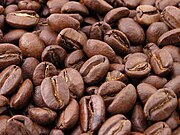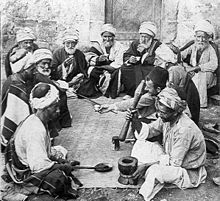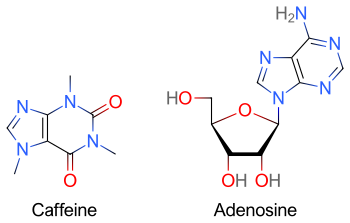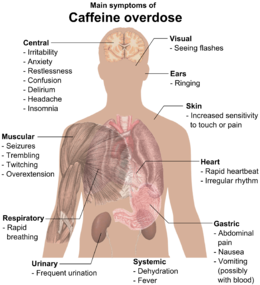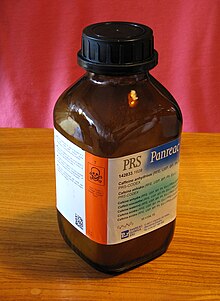Caffeine
| Caffeine | |
|---|---|
 |  |
 | |
| Identifiers | |
| CAS number | 58-08-2 |
| PubChem | 2519 |
| ChemSpider | 2424 |
| UNII | 3G6A5W338E |
| EC-number | 200-362-1 |
| DrugBank | DB00201 |
| ChEBI | 27732 |
| IUPHAR ligand | 407 |
| RTECS number | EV6475000 |
| Properties | |
| Molecular formula | C8H10N4O2 |
| Molar mass | 194.19 g/mol |
| Exact mass | 194.080376 u |
| Appearance | Odorless, white needles or powder |
| Density | 1.23 g/cm3, solid |
| Melting point | 227–228 °C (anhydrous); 234–235 °C (monohydrate) |
| Boiling point | 178 °C subl. |
| Solubility in water | 2.17 g/100 ml (25 °C) 18.0 g/100 ml (80 °C) 67.0 g/100 ml (100 °C) |
| Acidity (pKa) | −0.13–1.22[1] |
| Dipole moment | 3.64 D (calculated) |
| Hazards | |
| MSDS | ICSC 0405 |
| EU Index | 613-086-00-5 |
| EU classification | not listed |
| R-phrases | R22 |
| S-phrases | (S2) |
| NFPA 704 | |
| LD50 | 192 mg/kg (rat, oral)[2] |
| Except where noted otherwise, data are given for materials in their standard state (at 25 °C, 100 kPa) | |
| Infobox references | |
Caffeine is found in varying quantities in the beans, leaves, and fruit of some plants, where it acts as a natural pesticide that paralyzes and kills certain insects feeding on the plants.[5] It is most commonly consumed by humans in infusions extracted from the bean of the coffee plant and the leaves of the tea bush, as well as from various foods and drinks containing products derived from the kola nut. Other sources include yerba mate, guarana berries, and the Yaupon Holly.
In humans, caffeine acts as a central nervous system (CNS) stimulant, temporarily warding off drowsiness and restoring alertness. Caffeine is the world's most widely consumed psychoactive substance,[6] but, unlike many other psychoactive substances, is legal and unregulated in nearly all jurisdictions. Beverages containing caffeine, such as coffee, tea, soft drinks, and energy drinks, enjoy great popularity; in North America, 90% of adults consume caffeine daily.[6] The U.S. Food and Drug Administration (FDA) lists caffeine as a "multiple purpose generally recognized as safe food substance".[7]
Caffeine has diuretic properties when administered in sufficient doses to subjects that do not have a tolerance for it.[8] Regular users, however, develop a strong tolerance to this effect,[8] and studies have generally failed to support the common notion that ordinary consumption of caffeinated beverages contributes significantly to dehydration.[9][10][11]
Contents[show] |
[edit] Occurrence
Caffeine is found in many plant species, where it acts as a natural pesticide, with high caffeine levels being observed in seedlings that are still developing foliage, but are lacking mechanical protection;[12] Caffeine paralyzes and kills certain insects feeding upon the plant.[5] High caffeine levels have also been found in the surrounding soil of coffee bean seedlings. Therefore, it is understood that caffeine has a natural function as both a natural pesticide and an inhibitor of seed germination of other nearby coffee seedlings, thus giving it a better chance of survival.[13]Common sources of caffeine are coffee, tea, and (to a lesser extent) chocolate derived from cocoa beans.[14] Less commonly used sources of caffeine include the yerba maté and guarana plants,[15] which are sometimes used in the preparation of teas and energy drinks. Two of caffeine's alternative names, mateine and guaranine, are derived from the names of these plants.[16][17] Some yerba mate enthusiasts assert that mateine is a stereoisomer of caffeine, which would make it a different substance altogether.[15] This is not true because caffeine is an achiral molecule,[18] and therefore has no enantiomers; nor does it have other stereoisomers.[19] The disparity in experience and effects between the various natural caffeine sources could be because plant sources of caffeine also contain widely varying mixtures of other xanthine alkaloids, including the cardiac stimulants theophylline and theobromine, and other substances such as polyphenols that can form insoluble complexes with caffeine.[20]
One of the world's primary sources of caffeine is the coffee "bean" (which is the seed of the coffee plant), from which coffee is brewed. Caffeine content in coffee varies widely depending on the type of coffee bean and the method of preparation used;[21] even beans within a given bush can show variations in concentration. In general, one serving of coffee ranges from 80-100 milligrams, for a single shot (30 milliliters) of arabica-variety espresso, to approximately 100-125 milligrams for a cup (120 milliliters) of drip coffee. In general, dark-roast coffee has less caffeine than lighter roasts because the roasting process reduces the bean's caffeine content.[22][23] Arabica coffee normally contains less caffeine than the robusta variety.[21] Coffee also contains trace amounts of theophylline, but no theobromine.
Tea is another common source of caffeine. Although tea contains more caffeine than coffee (by dry weight), a typical serving contains much less, as tea is normally brewed much weaker. Besides strength of the brew, growing conditions, processing techniques- and other variables also affect caffeine content. Certain types of tea may contain somewhat more caffeine than other teas. Tea contains small amounts of theobromine and slightly higher levels of theophylline than coffee. Preparation and many other factors have a significant impact on tea, and color is a very poor indicator of caffeine content.[24] Teas like the pale Japanese green tea gyokuro, for example, contain far more caffeine than much darker teas like lapsang souchong, which has very little.
Product | Serving size | Caffeine per serving (mg) | Caffeine per liter (mg) |
|---|---|---|---|
| Caffeine tablet (regular-strength) | 1 tablet | 100 | — |
| Caffeine tablet (extra-strength) | 1 tablet | 200 | — |
| Excedrin tablet | 1 tablet | 65 | — |
| Hershey's Special Dark (45% cacao content) | 1 bar (43 g; 1.5 oz) | 31 | — |
| Hershey's Milk Chocolate (11% cacao content) | 1 bar (43 g; 1.5 oz) | 10 | — |
| Percolated coffee | 207 mL (7 U.S. fl oz) | 80–135 | 386–652 |
| Drip coffee | 207 mL (7 U.S. fl oz) | 115–175 | 555–845 |
| Coffee, decaffeinated | 207 mL (7 U.S. fl oz) | 5–15 | 24–72 |
| Coffee, espresso | 44–60 mL (1.5-2 U.S. fl oz) | 100 | 1,691–2254 |
| Black tea | 177 mL (6 U.S. fl oz) | 50 | 282 |
| Green tea | 177 mL (6 U.S. fl oz) | 30 | 170 |
| Guayakí Yerba Mate (loose leaf) | 6 g (0.2 U.S. oz) | 85[28] | 358 about |
| Coca-Cola Classic | 355 mL (12 U.S. fl oz) | 34 | 96 |
| Barq's Root Beer | 355 mL (12 U.S. fl oz) | 22.5 | 63 |
| Mountain Dew | 355 mL (12 U.S. fl oz) | 54 | 154 |
| Vault | 355 mL (12 U.S. fl oz) | 69 | 194 |
| Guaraná Antarctica | 350 mL (11 U.S. fl oz) | 30 | 100 |
| Monster energy drink | 500 mL (16.4 U.S. fl oz) | 160 | 320 |
| Jolt Cola | 695 mL (23.5 U.S. fl oz) | 280 | 403 |
| Red Bull | 250 mL (8.2 U.S. fl oz) | 80 | 320 |
Chocolate derived from cocoa beans contains a small amount of caffeine. The weak stimulant effect of chocolate may be due to a combination of theobromine and theophylline as well as caffeine.[30] A typical 28-gram serving of a milk chocolate bar has about as much caffeine as a cup of decaffeinated coffee, although some dark chocolate currently in production contains as much as 160 mg per 100g.
In recent years, various manufacturers have begun putting caffeine into shower products such as shampoo and soap.[31] Studies show that caffeine in shampoo applied for two minutes is absorbed through the skin, mostly through hair follicles, and reaches the blood stream.[32]
Various manufacturers market caffeine tablets, claiming that using caffeine of pharmaceutical quality improves mental alertness. These effects have been borne out by research that shows that caffeine use (whether in tablet form or not) results in decreased fatigue and increased attentiveness.[33] These tablets are commonly used by students studying for their exams and by people who work or drive for long hours.[34]
Caffeine is also used pharmacologically to treat apnea in premature newborns and as such is one of the 10 drugs most commonly given in neonatal intensive care,[35] though questions are now raised based on experimental animal research whether it might have subtle harmful side-effects.[35]
[edit] History
- Main articles: History of chocolate, History of coffee, Origin and history of tea
According to one popular Chinese legend, the Emperor of China Shennong, reputed to have reigned in about 3000 BCE, accidentally discovered that when some leaves fell into boiling water, a fragrant and restorative drink resulted.[37][38][39] Shennong is also mentioned in Lu Yu's Cha Jing, a famous early work on the subject of tea.[40] The history of coffee has been recorded as far back as the ninth century. During that time, coffee beans were available only in their native habitat, Ethiopia. A popular legend traces its discovery to a goatherder named Kaldi, who apparently observed goats that became elated and sleepless at night after grazing on coffee shrubs and, upon trying the berries that the goats had been eating, experienced the same vitality. The earliest literary mention of coffee may be a reference to Bunchum in the works of the 9th-century Persian physician al-Razi. In 1587, Malaye Jaziri compiled a work tracing the history and legal controversies of coffee, entitled ʕUmdat aṣ-Ṣafwa Fī Ḥill al-Qahwah. In this work, Jaziri recorded that one Sheikh, Jamal-al-Din al-Dhabhani, mufti of Aden, was the first to adopt the use of coffee in 1454, and that in the 15th century the Sufis of Yemen routinely used coffee to stay awake during prayers.
Towards the close of the 16th century, the use of coffee was recorded by a European resident in Egypt, and about this time it came into general use in the Near East. The appreciation of coffee as a beverage in Europe, where it was first known as "Arabian wine," dates from the 17th century. A legend states that, after the Ottoman Turks retreated from the walls of Vienna after losing a battle for the city, many sacks of coffee beans were found among their baggage. Europeans did not know what to do with all the coffee beans, being unfamiliar with them. So Franz George Kolschitzky, a Pole who had actually worked for the Turks, offered to take them. He subsequently taught the Viennese how to make coffee, and the first coffee house in the Western world was opened in Vienna, thus starting a long tradition of coffee appreciation.[41] In Britain, the first coffee houses were opened in London in 1652, at St Michael's Alley, Cornhill. They soon became popular throughout Western Europe, and played a significant role in social relations in the 17th and 18th centuries.[42]
Use of the kola nut, like the coffee berry and tea leaf, appears to have ancient origins. It is chewed in many West African cultures, individually or in a social setting, to restore vitality and ease hunger pangs. In 1911, kola became the focus of one of the earliest documented health scares when the US government seized 40 barrels and 20 kegs of Coca-Cola syrup in Chattanooga, Tennessee, alleging that the caffeine in its drink was "injurious to health".[43] On March 13, 1911, the government initiated United States v. Forty Barrels and Twenty Kegs of Coca-Cola, hoping to force Coca-Cola to remove caffeine from its formula by making claims that the product was adulterated and misbranded. The allegation of adulteration was, in substance, that the product contained an added poisonous or added deleterious ingredient: caffeine, which might render the product injurious to health. It was alleged to be misbranded in that the name 'Coca Cola' was a representation of the presence of the substances coca and cola; that the product 'contained no coca and little if any cola' and thus was an 'imitation' of these substances and was offered for sale under their 'distinctive name.'[44] Although the judge ruled in favor of Coca-Cola, two bills were introduced to the U.S. House of Representatives in 1912 to amend the Pure Food and Drug Act, adding caffeine to the list of "habit-forming" and "deleterious" substances, which must be listed on a product's label.
The earliest evidence of cocoa bean use comes from residue found in an ancient Mayan pot dated to 600 BCE. In the New World, chocolate was consumed in a bitter and spicy drink called xocolatl, often seasoned with vanilla, chile pepper, and achiote. Xocolatl was believed to fight fatigue, a belief that is probably attributable to the theobromine and caffeine content. Chocolate was an important luxury good throughout pre-Columbian Mesoamerica, and cocoa beans were often used as currency.
Xocolatl was introduced to Europe by the Spaniards and became a popular beverage by 1700. They also introduced the cacao tree into the West Indies and the Philippines. It was used in alchemical processes, where it was known as Black Bean.
The leaves and stems of the Yaupon Holly (Ilex vomitoria) were used by Native Americans to brew a tea called Asi or the "black drink".[45] Archaeologists have found evidence of this use stretch back far into antiquity, possibly dating to Late Archaic times.
[edit] Synthesis and properties
In 1819, the German chemist Friedrich Ferdinand Runge isolated relatively pure caffeine for the first time.[46][47] According to Runge, he did this at the behest of Johann Wolfgang von Goethe.[48] In 1827, Oudry isolated "theine" from tea,[49] but it was later proved by Mulder[50] and by Jobst[51] that theine was the same as caffeine.[48] The structure of caffeine was elucidated near the end of the 19th century by Hermann Emil Fischer, who was also the first to achieve its total synthesis.[52] This was part of the work for which Fischer was awarded the Nobel Prize in 1902. The nitrogen atoms are all essentially planar (in sp2 orbital hybridization), resulting in the caffeine molecule's having aromatic character. Being readily available as a byproduct of decaffeination, caffeine is not usually synthesized.[53] If desired, it may be synthesized from dimethylurea and malonic acid.[54][edit] Pharmacology
[edit] Metabolism and half-life

The biological half-life of caffeine — the time required for the body to eliminate one-half of the total amount of caffeine — varies widely among individuals according to such factors as age, liver function, pregnancy, some concurrent medications, and the level of enzymes in the liver needed for caffeine metabolism. In healthy adults, caffeine's half-life is approximately 4.9 hours.[61] In women taking oral contraceptives, this is increased to 5–10 hours,[62] and in pregnant women the half-life is roughly 9–11 hours.[63]
Caffeine can accumulate in individuals with severe liver disease, increasing its half-life up to 96 hours.[64] In infants and young children, the half-life may be longer than in adults; half-life in a newborn baby may be as long as 30 hours. Other factors such as smoking can shorten caffeine's half-life.[65] Fluvoxamine (Luvox) reduced the clearance of caffeine by 91.3%, and prolonged its elimination half-life by 11.4-fold; from 4.9 hours to 56 hours.[61]
Caffeine is metabolized in the liver by the cytochrome P450 oxidase enzyme system (to be specific, the 1A2 isozyme) into three metabolic dimethylxanthines,[66] each of which has its own effects on the body:
- Paraxanthine (84%): Has the effect of increasing lipolysis, leading to elevated glycerol and free fatty acid levels in the blood plasma.
- Theobromine (12%): Dilates blood vessels and increases urine volume. Theobromine is also the principal alkaloid in the cocoa bean, and therefore chocolate.
- Theophylline (4%): Relaxes smooth muscles of the bronchi, and is used to treat asthma. The therapeutic dose of theophylline, however, is many times greater than the levels attained from caffeine metabolism.
[edit] Mechanism of action
Adenosine is found in every part of the body, because it plays a role in the fundamental ATP-related energy metabolism and is necessary for RNA synthesis, but it has special functions in the brain. There is a great deal of evidence that concentrations of brain adenosine are increased by various types of metabolic stress including anoxia and ischemia. The evidence also indicates that brain adenosine acts to protect the brain by suppressing neural activity and also by increasing blood flow through A2A and A2B receptors located on vascular smooth muscle.[69] By counteracting adenosine, caffeine reduces resting cerebral blood flow between 22% and 30%.[70] Caffeine also has a generally disinhibitory effect on neural activity. It has not been shown, however, how these effects cause increases in arousal and alertness.
Adenosine is released in the brain through a complex mechanism.[69] There is evidence that adenosine functions as a synaptically released neurotransmitter in some cases, but stress-related adenosine increases appear to be produced mainly by extracellular metabolism of ATP. It is not likely that adenosine is the primary neurotransmitter for any group of neurons, but rather that it is released together with other transmitters by a number of neuron types. Unlike most neurotransmitters, adenosine does not seem to be packaged into vesicles that are released in a voltage-controlled manner, but the possibility of such a mechanism has not been completely ruled out.
Several classes of adenosine receptors have been described, with different anatomical distributions. A1 receptors are widely distributed, and act to inhibit calcium uptake. A2A receptors are heavily concentrated in the basal ganglia, an area that plays a critical role in behavior control, but can be found in other parts of the brain as well, in lower densities. There is evidence that A 2A receptors interact with the dopamine system, which is involved in reward and arousal. (A2A receptors can also be found on arterial walls and blood cell membranes.)
Beyond its general neuroprotective effects, there are reasons to believe that adenosine may be more specifically involved in control of the sleep-wake cycle. Robert McCarley and his colleagues have argued that accumulation of adenosine may be a primary cause of the sensation of sleepiness that follows prolonged mental activity, and that the effects may be mediated both by inhibition of wake-promoting neurons via A1 receptors, and activation of sleep-promoting neurons via indirect effects on A2A receptors.[71] More recent studies have provided additional evidence for the importance of A2A, but not A1, receptors.[72]
Some of the secondary effects of caffeine are probably caused by actions unrelated to adenosine. Like other methylated xanthines, caffeine is both a
- competitive nonselective phosphodiesterase inhibitor [73] which raises intracellular cAMP, activates PKA, inhibits TNF-alpha [74][75] and leukotriene [76] synthesis, and reduces inflammation and innate immunity.[76] Caffeine is also added to agar, which partially inhibits the growth of Saccharomyces cerevisiae by inhibiting cyclic AMP phosphodiesterase.[77]
- nonselective adenosine receptor antagonist [68] (see above).
Metabolites of caffeine also contribute to caffeine's effects. Paraxanthine is responsible for an increase in the lipolysis process, which releases glycerol and fatty acids into the blood to be used as a source of fuel by the muscles. Theobromine is a vasodilator that increases the amount of oxygen and nutrient flow to the brain and muscles. Theophylline acts as a smooth muscle relaxant that chiefly affects bronchioles and acts as a chronotrope and inotrope that increases heart rate and efficiency.[79]
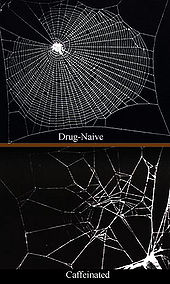
[edit] Effects when taken in moderation

With these effects, caffeine is an ergogenic, increasing a person's capability for mental or physical labor. A study conducted in 1979 showed a 7% increase in distance cycled over a period of two hours in subjects that consumed caffeine compared to control subjects.[83] Other studies attained much more dramatic results; one particular study of trained runners showed a 44% increase in "race-pace" endurance, as well as a 51% increase in cycling endurance, after a dosage of 9 milligrams of caffeine per kilogram of body weight.[84] Additional studies have reported similar effects. Another study found 5.5 milligrams of caffeine per kilogram of body mass resulted in subjects cycling 29% longer during high-intensity circuits.[85]
Caffeine citrate has proven to be of short- and long-term benefit in treating the breathing disorders of apnea of prematurity and bronchopulmonary dysplasia in premature infants.[80] The only short-term risk associated with caffeine citrate treatment is a temporary reduction in weight gain during the therapy,[86] and longer term studies (18 to 21 months) have shown lasting benefits of treatment of premature infants with caffeine.[87]
Caffeine relaxes the internal anal sphincter muscles and thus should be avoided by those with fecal incontinence.[88]
While relatively safe for humans, caffeine is considerably more toxic to some other animals such as dogs, horses, and parrots due to a much poorer ability to metabolize this compound. Caffeine has also a pronounced effect on mollusks and various insects as well as spiders.[89]
Caffeine may also have hepatoprotective properties. Studies have shown that increased caffeine consumption is associated with less severe liver injury among those at high risk for liver disease, such as those with alcoholism, obesity, or hemochromatosis. The mechanism by which this occurs is not known.[90][91]
[edit] Tolerance and withdrawal
Other research questions the idea that up-regulation of adenosine receptors is responsible for tolerance to the locomotor stimulant effects of caffeine, noting, among other things, that this tolerance is insurmountable by higher doses of caffeine (it should be surmountable if tolerance were due to an increase in receptors), and that the increase in adenosine receptor number is modest and does not explain the large tolerance that develops to caffeine.[93]
Caffeine tolerance develops very quickly, especially among heavy coffee and energy drink consumers. Complete tolerance to the sleep disruption effects of caffeine develops after consuming 400 mg of caffeine 3 times a day for 7 days. Complete tolerance to subjective effects of caffeine was observed to develop after consuming 300 mg 3 times per day for 18 days, and possibly even earlier.[94] In another experiment, complete tolerance of caffeine was observed when the subject consumed 750–1200 mg per day while incomplete tolerance to caffeine has been observed in those that consume more average doses of caffeine.[95]
Because adenosine, in part, serves to regulate blood pressure by causing vasodilation, the increased effects of adenosine due to caffeine withdrawal cause the blood vessels of the head to dilate, leading to an excess of blood in the head and causing a headache and nausea. This means caffeine has vasoconstriction properties.[96] Reduced catecholamine activity may cause feelings of fatigue and drowsiness. A reduction in serotonin levels when caffeine use is stopped can cause anxiety, irritability, inability to concentrate, and diminished motivation to initiate or to complete daily tasks; in extreme cases it may cause mild depression. Together, these effects have come to be known as a "crash".[97]
Withdrawal symptoms — possibly including headache, irritability, an inability to concentrate, drowsiness, insomnia and pain in the stomach, upper body, and joints[98] — may appear within 12 to 24 hours after discontinuation of caffeine intake, peak at roughly 48 hours, and usually last from one to five days, representing the time required for the number of adenosine receptors in the brain to revert to "normal" levels, uninfluenced by caffeine consumption. Analgesics, such as aspirin, may relieve the pain symptoms, as may a small dose of caffeine.
[edit] Overuse
In large amounts, and especially over extended periods of time, caffeine can lead to a condition known as caffeinism.[99][100] Caffeinism usually combines caffeine dependency with a wide range of unpleasant physical and mental conditions including nervousness, irritability, anxiety, tremulousness, muscle twitching (hyperreflexia), insomnia, headaches, respiratory alkalosis, and heart palpitations.[101][102] Furthermore, because caffeine increases the production of stomach acid, high usage over time can lead to peptic ulcers, erosive esophagitis, and gastroesophageal reflux disease.[103] Caffeine may also increase the toxicity of certain other drugs, such as paracetamol.[104]There are four caffeine-induced psychiatric disorders recognized by the Diagnostic and Statistical Manual of Mental Disorders, Fourth Edition: caffeine intoxication, caffeine-induced anxiety disorder, caffeine-induced sleep disorder, and caffeine-related disorder not otherwise specified (NOS).
[edit] Caffeine intoxication
Extreme overdose can result in death.[108] The median lethal dose (LD50) given orally, is 192 milligrams per kilogram in rats.[2] The LD50 of caffeine in humans is dependent on weight and individual sensitivity and estimated to be about 150 to 200 milligrams per kilogram of body mass, roughly 80 to 100 cups of coffee for an average adult taken within a limited time frame that is dependent on half-life. Though achieving lethal dose with caffeine would be exceptionally difficult with regular coffee, there have been reported deaths from overdosing on caffeine pills, with serious symptoms of overdose requiring hospitalization occurring from as little as 2 grams of caffeine. An exception to this would be taking a drug such as fluvoxamine, which blocks the liver enzyme responsible for the metabolism of caffeine, thus increasing the central effects and blood concentrations of caffeine dramatically at 5-fold. It is not contraindicated, but highly advisable to minimize the intake of caffeinated beverages, as drinking one cup of coffee will have the same effect as drinking five under normal conditions.[109][110][111][112] Death typically occurs due to ventricular fibrillation brought about by effects of caffeine on the cardiovascular system.
Treatment of severe caffeine intoxication is generally supportive, providing treatment of the immediate symptoms, but if the patient has very high serum levels of caffeine then peritoneal dialysis, hemodialysis, or hemofiltration may be required.
[edit] Detection in biological fluids
Caffeine can be quantified in blood, plasma, or serum to monitor therapy in neonates, confirm a diagnosis of poisoning, or facilitate a medicolegal death investigation. Plasma caffeine levels are usually in the range of 2–10 mg/L in coffee drinkers, 12–36 mg/L in neonates receiving treatment for apnea, and 40–400 mg/L in victims of acute overdosage. Urinary caffeine concentration is frequently measured in competitive sports programs, for which a level in excess of 15 mg/L is usually considered to represent abuse.[113][edit] Anxiety and sleep disorders
Two infrequently diagnosed caffeine-induced disorders that are recognized by the American Psychological Association (APA) are caffeine-induced sleep disorder and caffeine-induced anxiety disorder, which can result from long-term excessive caffeine intake.In the case of caffeine-induced sleep disorder, an individual regularly ingests high doses of caffeine sufficient to induce a significant disturbance in his or her sleep, sufficiently severe to warrant clinical attention.[105]
In some individuals, large amounts of caffeine can induce anxiety severe enough to necessitate clinical attention. This caffeine-induced anxiety disorder can take many forms, from generalized anxiety to panic attacks, obsessive-compulsive symptoms, or even phobic symptoms.[105] Because this condition can mimic organic mental disorders, such as panic disorder, generalized anxiety disorder, bipolar disorder, akathisia, or even schizophrenia, a number of medical professionals believe caffeine-intoxicated people are routinely misdiagnosed and unnecessarily medicated when the treatment for caffeine-induced psychosis would simply be to stop further caffeine intake.[114] A study in the British Journal of Addiction concluded that caffeinism, although infrequently diagnosed, may afflict as many as one person in ten of the population.[100]
[edit] Effects on memory and learning
An array of studies found that caffeine could have nootropic effects, inducing certain changes in memory and learning.Researchers have found that long-term consumption of low dose caffeine slowed hippocampus-dependent learning and impaired long-term memory in mice. Caffeine consumption for 4 weeks also significantly reduced hippocampal neurogenesis compared to controls during the experiment. The conclusion was that long-term consumption of caffeine could inhibit hippocampus-dependent learning and memory partially through inhibition of hippocampal neurogenesis.[115]
In another study, caffeine was added to rat neurons in vitro. The dendritic spines (a part of the brain cell used in forming connections between neurons) taken from the hippocampus (a part of the brain associated with memory) grew by 33% and new spines formed. After an hour or two, however, these cells returned to their original shape.[116]
Another study showed that human subjects — after receiving 100 milligrams of caffeine — had increased activity in brain regions located in the frontal lobe, where a part of the working memory network is located, and the anterior cingulate cortex, a part of the brain that controls attention. The caffeinated subjects also performed better on the memory tasks.[117]
However, a different study showed that caffeine could impair short-term memory and increase the likelihood of the tip of the tongue phenomenon. The study allowed the researchers to suggest that caffeine could aid short-term memory when the information to be recalled is related to the current train of thought, but also to hypothesize that caffeine hinders short-term memory when the train of thought is unrelated.[118] In essence, caffeine consumption increases mental performance related to focused thought while it may decrease broad-range thinking abilities.
[edit] Effects on the heart
Caffeine binds to receptors on the surface of heart muscle cells, which leads to an increase in the level of cAMP inside the cells (by blocking the enzyme that degrades cAMP), mimicking the effects of epinephrine (which binds to receptors on the cell that activate cAMP production). cAMP acts as a "second messenger," and activates a large number of protein kinase A (PKA; cAMP-dependent protein kinase). This has the overall effect of increasing the rate of glycolysis and increases the amount of ATP available for muscle contraction and relaxation. According to one study, caffeine in the form of coffee, significantly reduces the risk of heart disease in epidemiological studies. However, the protective effect was found only in participants who were not severely hypertensive (i.e., patients that are not suffering from a very high blood pressure). Furthermore, no significant protective effect was found in participants aged less than 65 years or in cerebrovascular disease mortality for those aged equal or more than 65 years.[119] Research also suggests that drinking caffeinated coffee can cause a temporary increase in the stiffening of arterial walls.[120][edit] Effects on children
It is a common myth that excessive intake of caffeine results in stunted growth within children, particularly younger children and teenagers—recently, scientific studies have disproved the notion.[121] Children are found to experience the same effects from caffeine as adults.However, subsidiary beverages that contain caffeine, such as energy drinks, most of which contain high amounts of caffeine, have been banned in many schools throughout the world, due to other adverse effects having been observed in prolonged consumption of caffeine.[122] In one study, caffeinated cola has been linked to hyperactivity in children.[123]
[edit] Caffeine intake during pregnancy
A 2008 study suggested that pregnant women who consume 200 milligrams or more of caffeine per day have about twice the miscarriage risk as women who consume none. However, another 2008 study found no correlation between miscarriage and caffeine consumption.[124] The UK Food Standards Agency has recommended that pregnant women should limit their caffeine intake to less than 200 mg of caffeine a day—the equivalent of two cups of instant coffee, or one half to two cups of fresh coffee.[125][126] The FSA noted that the design of the studies made it impossible to be certain that the differences were due to caffeine per se, instead of other lifestyle differences possibly associated with high levels of caffeine consumption, but judged the advice to be prudent.Dr De-Kun Li of Kaiser Permanente Division of Research, writing in the American Journal of Obstetrics and Gynecology, concluded that an intake of 200 milligrams or more per day, representing two or more cups, "significantly increases the risk of miscarriage".[127] However, Dr. David A. Savitz, a professor in community and preventive medicine at New York's Mount Sinai School of Medicine and lead author of the other new study on the subject published in the January issue of Epidemiology, found no link between miscarriage and caffeine consumption.[124]
[edit] Effects on exercise recovery
A 2008 study at RMIT University in Bundoora, Australia and published in the Journal of Applied Physiology found a correlation between caffeine ingestion and the rate at which the body replenishes its muscle glycogen stores. The ingestion of caffeine along with carbohydrates after an exhaustive workout resulted in a 60% increase in the body's storage of muscle glycogen when compared to participants who did not ingest the caffeine.[128] The dosage used was 8 mg per kilogram (17.6 mg per pound) of body weight.[edit] Genetics and caffeine metabolism
A 2006 study by Dr. Ahmed El-Sohemy at the University of Toronto discovered a link between a gene affecting caffeine metabolism and the effects of coffee on health.[129] Some people metabolize caffeine more slowly than the general population due to variations in a specific cytochrome P450 gene,[130] and there is evidence people with this gene may be at a higher risk of myocardial infarction when consuming large amounts of coffee. For rapid metabolizers, however, coffee seemed to have a preventative effect. Slow and fast metabolizers are comparably common in the general population, and this has been blamed for the wide variation in studies of the health effects of caffeine.[edit] Intraocular pressure and caffeine
Recent data has suggested that caffeine consumption can raise intraocular pressure.[131] This may be a significant consideration for those with open angle glaucoma.[132][edit] Decaffeination


